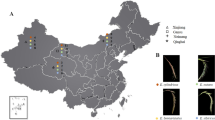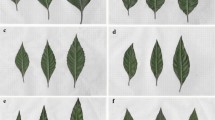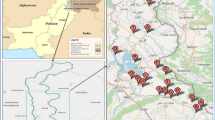Abstract
Prosopis alba is an important Argentinean species with a great potential for the production of timber and nontimber products. Many studies showed high salt tolerance of this species, which allows it to be used in afforestation and reforestation of saline soils. In this study, we applied the morphometric technique to characterize 21 salt-tolerant clones (ST). Twenty of these clones were studied by inter-simple sequence repeat (ISSR) and simple sequence repeat (SSR), and their molecular patterns were compared with those of 22 individuals selected for salt sensitivity (SS). Most morphological traits revealed highly significant differences among ST clones, and four out of 11 characters showed high heritability. ISSR analysis allowed detecting 89 loci, 91 % of them variable. ST versus SS groups differ significantly from each other by the frequencies of 22 of these loci, from which 12 were significant at the matrix level. Analysis of six SSR loci for the same groups indicated that all of them were polymorphic at the 1 % criterion. Allelic frequencies of SSR also showed highly significant differences between SS and ST groups. Analysis of coancestry between individuals within SS and ST groups and between groups indicated that the molecular differentiation between them cannot be explained solely on relationship grounds. Molecular groupings based on ISSR and SSR showed consistency to each other, as supported by the highly significant coinertia in the distribution of individuals in principal component analysis scatterplots. This work is the first contribution which tends to associate molecular patterns with life history traits and morphological differences in Prosopis clones.







Similar content being viewed by others
References
Ahmad R, Ismail S, Moinuddin M, Shaheen T (1994) Screening of mesquite (Prosopis sp) for biomass production at barren sandy areas using highly saline water for irrigation. Pak J Bot 26:265–282
Aiazzi M, Carpane P, Di Rienzo J, Arguello J (2002) Effects of salinity and temperature on the germination and early seedling growth of Atriplex cordobensis (Gandoger et Stuckert) (Chenopodiaceae). Seed Sci Technol 30:329–338
Alban L, Matorel M, Romero J, Grados N, Cruz G, Felker P (2002) Cloning of elite, multipurpose trees of the Prosopis juliflora/pallida complex in Piura, Peru. Agrofor Syst 54:173–182
Baker A, Sprent JI, Wilson J (1995) Effects of sodium chloride and mycorrhizal infection on the growth and nitrogen fixation of Prosopis juliflora. Symbiosis 19:39–51
Bassam BJ, Caetano Anollés G, Gresshoff PM (1991) Fast and sensitive silver staining of DNA in polyacrylamide gels. Anal Biochem 19:80–83
Benjamini Y, Hochberg Y (1995) Controlling the false discovery rate: a practical and powerful approach to multiple testing. J Roy Stat Soc B Met 57:289–300
Bessega C, Ferreyra LI, Julio N, Montoya S, Saidman BO, Vilardi JC (2000) Mating system parameters in species of genus Prosopis (Leguminosae). Hereditas 132:19–27
Bessega C, Saidman BO, Darquier MR, Ewens M, Leopoldo S, Rozenberg P, Vilardi JC (2009) Consistency between marker and genealogy based heritability estimates in an experimental stand of Prosopis alba ( Leguminosae). Am J Bot 96:458–465. doi:10.37327ajb.0800074
Bessega C, Saidman BO, Darquier MR, Ewens M, Felker P, Vilardi JC (2010) Accuracy of dominant markers for estimation of relatedness and heritability in an experimental stand of Prosopis alba (Leguminosae). Tree Genet Genomes 7(1):103–115. doi:10.1007/s11295-010-0318-6
Bessega C, Pometti CL, Ewens M, Saidman BO, Vilardi JC (2012) Strategies for conservation for disturbed Prosopis alba (Leguminosae, Mimosoidae) forests based on mating system and pollen dispersal parameters. Tree Genet Genomes 8(2):277–288. doi:10.1007/s11295-011-0439-6
Breiman L, Friedman J, Olshen R, Stone C (1993) Classification and regression trees. Chapman and Hall/CRC, Boca Raton
Burkart A (1976) A monograph of the genus Prosopis (Leguminosae subfam. Mimosoidae). J Arnold Arboretum 57:219–249
Carnevale NJ, Alzugaray C, Lopez D (2004) Effect of salinity on seedlings of two dominant tree species in the “Quebrachal” of Schinopsis balansae Engl. Rev Investig Fac Cien Agrarias 6:43–49
Cavagnaro JB, Ponce M, Guzmán J, Cirrincione M (2006) Argentinean cultivars of Vitis vinifera grow better than European ones when cultured in vitro under salinity. Biocell 30:1–7
Chen K, Ren P,Ying C, Jiang Q, Jia X (2011) Genetic relationships among Jatropa curcas L. clones from Panzhihua, China as revealed by RAPD and ISSR. Afr J Agric Res 6(11):2582-2585. Available online at http://www.academicjournals.org/AJAR
Chessel D, Dufour AB, Thioulouse J (2004) The ade4 package—I: One-table methods. R News 4:5–10
Cony MA (1995) Reforestación racional de zonas áridas y semiáridas con árboles de múltiples propósitos. Interciencia 20:249–253
Cony MA (1996) Genetic variability in Prosopis flexuosa DC, a native tree of the Monte phytogeographic province, Argentina. For Ecol Manag 87:41–49
Cony MA, Trione SO (1998) Inter and intraspecific variability in Prosopis flexuosa and Prosopis chilensis: seed germination under salt and moisture stress. J Arid Environ 40:307–317
Culhane AC, Perrière G, Considine EC, Cotter TG, Higgins DG (2002) Between-group analysis of microarray data. Bioinformatics 18(12):1600–8
Culhane AC, Perrière G, Higgins DG (2003) Cross-platform comparison and visualization of gene expression data using co-inertia analysis. BMC Bioinforma 15:1–15
Darquier MR, Bessega CF, Cony M, Vilardi JC, Saidman BO (2013) Evidence of heterogeneous selection on quantitative traits of Prosopis flexuosa (Leguminosae) from multivariate QST-FST test. Tree Genet Genomes 9(1):307–320
De Leeuw J, Mair P (2009) Multidimensional scaling using majorization: the R package smacof. J Stat Softw 31(3):1–30
De Pasquale F, Siragusa M, Abbate L, Tusa N (2006) Characterization of five sour orange clones through molecular markers and leaf essential oils analysis. Sci Hortic-Amst 109:54–59
Dolédec S, Chessel D (1987) Rhythmes saisonniers et composantes stationelles en milieu aquatique I-Description d’un plan d’observations complet par projection de variables. Acta Oecol Oecol Gen 8:403–426
Dolédec S, Chessel D (1994) Co-inertia analysis: an alternative method for studying species-environment relationships. Freshw Biol 31:277–293
Dray S, Dufour AB (2007) The ade4 package: implementing the duality diagram for ecologists. J Stat Soft 22:1–20
Dray S, Chessel D, Thioulouse J (2003) Co-inertia analysis and the linking of ecological data tables. Ecology 84:078–3089
Dutton RW (1989) Prosopis sp: a justification for their future research and development. In: Dutton R (ed) A research and development strategy for Prosopis. Center for Overseas Research and Development, Durham, pp 33–40
Epstein E, Kingsbury RW, Norlyn JD, Rush DW (1979) Production of food crops and other biomass by seawater culture. In: Hollaender A (ed) The biosaline concept. Plenum, New York, p 39
Ewens M, Gezan S, Felker P (2012) Five year field evaluation of Prosopis alba clones on pH 9–10 soils in Argentina selected for growth in the greenhouse at seawater salinities (45 dS m−1). Forests 3(1):95–113. doi:10.3390/f3010095
Fagg CW, Stewart JL (1994) The value of Acacia and Prosopis in arid and semi-arid environments. J Arid Environ 27:3–25
Felker P, Guevara JC (2003) Potential of commercial hardwood forestry plantations in arid lands and economic analyses of Prosopis lumber production in Argentina and the United States. For Ecol Manag 186(1–3):271–286
Felker P, Clark PR, Laag AE, Pratt PF (1981) Salinity tolerance of the tree legumes mesquite (Prosopis glandulosa, var torreyana, P. velutina and P. articulata) algarrobo (P. chilensis), kiawe (P. pallida) and tamarugo (P. tamarugo) grown in sand culture on nitrogen free media. Plant Soil 61:311–317
Felker P, Cannell GH, Osborn JF, Clark PR, Nash P (1983a) Effects of irrigation on biomass production of 32 Prosopis (mesquite) accessions. Exp Agr 19:187–198
Felker P, Cannell GH, Clark PR, Osborn JF, Nash P (1983b) Biomass production of Prosopis species (mesquite), Leucaena, and other leguminous trees grown under heat/drought stress. For Sci 29:592–606
Felker P, Lopez C, Soulier C, Ochoa J, Abdala R, Ewens M (2001) Genetic evaluation of Prosopis alba (algarrobo) in Argentina for cloning elite trees. Agrofor Syst 53(1):65–76. doi:10.1023/A:1012016319629
Felker P, Grados N, Cruz G, Prokopiuk D (2003) Economic assessment of production of flour from Prosopis alba and P. pallida pods for human food applications. J Arid Environ 53(4):517–528
Felker P, Ewens M, Velarde M, Medina D (2008) Initial evaluation of Prosopis alba Griseb clones selected for growth at seawater salinities. Arid Land Res Manag 22:334–345
Ferreyra LI, Bessega C, Vilardi JC, Saidman BO (2004) First report on RAPD patterns able to differentiate some Argentinean species of section Algarobia (Prosopis, Leguminosae). Genetica 121:33–42. doi:10.1023/B:GENE.0000019925.06080.c7
Ferreyra LI, Bessega C, Vilardi JC, Saidman BO (2007) Consistency of population genetics parameters estimated from isozyme and RAPDs dataset in species of genus Prosopis. Genetica 131:217–230. doi:10.1007/s10709-006-9132-3
Ferreyra LI, Vilardi JC, Tosto D, Julio N, Saidman BO (2010) Adaptive genetic diversity and population structure of the “algarrobo” [Prosopis chilensis (Molina) Stuntz] analyzed by RAPD and isozyme markers. Eur J For Res 129:1011–1025. doi:10.1007/s10342-010-0386-z
Flowers TJ, Yeo AR (1995) Breeding for salinity resistance in crop plants: where next? Aust. J. Plant Physiol 22:875–884
Foulkes AS (2009) Applied statistical genetics with R for population based association studies. Springer, New York
Gailing O, Lind J, Lilleskov E (2012) Leaf morphological and genetic differentiation between Quercus rubra L. and Q. elliposidalis E. J. Hill populations in contrasting environments. Pl Syst Evol 298:1533–1545. doi:10.1007/s00606-012-0656-y
Geesing D, Felker P, Bingham RL (2000) Influence of mesquite (Prosopis glandulosa) on soil nitrogen and carbon development: implications for global C sequestration. J Arid Environ 46:157–180
Harsh LN, Tewari JC, Sharma NK, Felker P (1996) Performance of Prosopis species in arid regions of India. In: Felker P, Moss J (eds) Prosopis: semi-arid fuelwood and forage tree: building consensus for the disenfranchised. Proceedings of an international symposium. Washington, DC. Center for Semi-Arid Forest Resources Publisher, TAMU Kingsville, Texas, pp 330
Hunziker JH, Saidman BO, Naranjo CA, Palacios RA, Poggio L, Burghardt AD (1986) Hybridization and genetic variation of Argentine species of Prosopis. For Ecol Manag 16:301–315
Ibitoye DO, Akin-Idowu PE (2010) Marker-assisted selection (MAS): a fast track to increase genetic gain in horticultural crop breeding. J Biotechnol 9(52):8889–8895
Jombart T (2008) adegenet: a R package for the multivariate analysis of genetic markers. Bioinformatics 24:1403–1405. doi:10.1093/bioinformatics/btn129
Karhunen M, Ovaskainen O (2012) Estimating population-level coancestry coefficients by an admixture F model. Genetics 192(2):609–617. doi:10.1534/genetics.112.140871
Kesari V, Sathyanarayana VM, Parida A, Rangan L (2010) Molecular marker-based characterization in candidate plus trees of Pongamia pinnata, a potential biodiesel legume. AoB Plants 17:1–12. doi:10.1093/aobpla/plq017
Lavado R (2008) Visión sintética de la distribución y magnitud de los suelos afectados por salinidad en la Argentina. In: Taleisnik E, Grunberg K, Santa María G (eds) La salinización de suelos en la Argentina: su impacto en la producción agropecuaria. EDUCC (Editorial Universidad Católica de Córdoba), Córdoba, pp 11–16
Mantel NA (1967) The detection of disease clustering and a generalized regression approach. Cancer Res 27:209–220
Marcucci Poltri SN, Zelener N, Rodriguez Traverso J, Gelid P, Hopp HE (2003) Selection of a seed orchard of Eucalyptus dunnii based on genetic diversity criteria calculated using molecular markers. Tree Physiol 23:625–632
Meloni DA, Matínez CA (2009) Glycinebetaine improves salt tolerance in vinal (Prosopis ruscifolia Griseb.) seedlings. Braz J Plant Physiol 21(3):233–241
Meloni DA, Gulotta MR, Martínez CA (2008a) Prosopis ruscifolia Griseb. (vinal) tolera concentraciones salinas equivalentes al agua de mar y excluye iones tóxicos de la parte aérea. Quebracho 16:32–40
Meloni DA, Gulotta MR, Martínez CA (2008b) Salinity tolerance in Schinopsis quebracho colorado: seed germination, growth, ion relations and metabolic responses. J Arid Environ 72:1785–1792
Monte-Corvo L, Goulão L, Oliveira C (2011) ISSR analysis of cultivars of pear and suitability of molecular markers for clone discrimination. J Am Soc Hort Sci 126:517–522
Mottuora MC, Finkeldey R, Verga AR, Gailing O (2005) Development and characterization of microsatellite markers for Prosopis chilensis and Prosopis flexuosa and cross-species amplification. Mol Ecol Notes 5:487–489
Ouahmane L, Hafidi M, Kisa M, Boumezouch A, Thioulouse J, Plenchette C, Duponnois R (2006) Some Mediterranean plant species (Lavandula spp. and Thymus satureioides) act as “plant nurses” for the early growth of Cupressus atlantica. Plant Ecol 185:123–134
Palacios RA, Bravo LD (1981) Hibridización natural en Prosopis (Leguminosae) en la región chaqueña Argentina. Evidencias morfológicas y cromatográficas. Darwiniana 23:3–35
Pasiecznik NM, Felker P, Harris PJC, Harsh LN, Cruz G, Tewari JC, Cadoret K, Maldonado LJ (2001) The Prosopis juliflora-Prosopis pallida complex: a monograph. HDRA, Coventry
Pinheiro J, Bates D, DebRoy S, Sarkar D and the R Development Core Team (2013) nlme: linear and nonlinear mixed effects models. R package version 3.1-109
Pometti C, Pizzo B, Brunetti M, Macchioni N, Ewens M, Saidman B (2009) Argentinean native wood species: physical and mechanical characterization of some Prosopis species and Acacia aroma (Leguminosae; Mimosoideae). Bioresour Technol 100(6):1999–2004
Pometti C, Palanti S, Pizzo B, Charpentier JP, Boizot N, Resio C, Saidman B (2010) Durability of five native Argentine wood species of the genera Prosopis and Acacia decayed by rot fungi and its relationship with extractive content. Biodegradation 21(5):753–60
Qadir M, Tubeileh A, Akhtar J, Larbi A, Minhas PS, Khan MA (2008) Productivity enhancement of salt-affected environments through crop diversification. Land Degrad Dev 19:429–453
R Development Core Team (2012) R: a language and environment for statistical computing. R Foundation for Statistical Computing: Vienna. ISBN 3-900051-07-0. Available from: http://www.R-project.org
Rains DW (1991) Salinity and alkalinity as an issue in world agriculture. In: Choukr-Allah R (ed) Plant salinity research. New challenges. Institut Agronomique et veterinaire Hassan II, Agadir, pp 19–31
Reddy MP, Sarla N, Siddiq EA (2002) Inter simple sequence repeat (ISSR) polymorphism and its application in plant breeding. Euphytica 128:9–17
Rhodes D, Felker P (1988) Mass screening Prosopis (mesquite) seedlings for growth at seawater salinity. For Ecol Manag 24:169–176
Roig FA (1993) Aportes a la etnobotánica del género Prosopis. In: IADIZA (ed) Contribuciones Mendocinas a la Quinta Reunión de Regional para América Latina y el Caribe de la Red de Forestación del CIID. Conservación y Mejoramiento de Especies del Género Prosopis, Mendoza, Argentina, pp 99-119
Saidman BO, Bessega C, Ferreyra LI, Julio N, Vilardi JC (2000) The use of genetic markers to assess populations structure and relationships among species of the genus Prosopis (Leguminosae). Bol Soc Arg Bot 35:315–324
Senthil Kumar R, Parthiban KT, Govinda Rao M (2009) Molecular characterization of Jatropha genetic resources through inter-simple sequence repeat (ISSR) markers. Mol Biol Rep 6:1951–1956
Smith JSC, Smith OS (1989) The description and assessment of distances between inbred lines of maize. II. The utility of morphological, biochemical and genetic descriptors and a scheme for testing of distinctiveness between inbred lines. Maydica 34:151–161
Taleisnik E, Lopez Lauestein D (2011) Leñosas perennes para ambientes afectados por salinidad. Una sinopsis de la contribución argentina a este tema. Ecología Aust 21:3–14
Therneau TM, Atkinson BR, port by Brian Ripley. <atkinson@mayo.edu > (2011) rpart: recursive partitioning. R package version 3.1-50. http://CRAN.R-project.org/package = rpart
Truntzer C, Mercier C, Gautier C, Roy P (2007) Importance of data structure in comparing two dimension reduction methods for classification of microarray gene expression data. BMC Bioinforma 12:1–12. doi:10.1186/1471-2105-8-90
UPOV (1995) Working group on biochemical and molecular techniques and DNA-profiling in particular. Third session. Identification methods based on molecular techniques. Wageningen, The Netherlands
Velarde M, Felker P, Degano C (2003) Evaluation of Argentine and Peruvian Prosopis germplasm for growth at seawater salinities. J Arid Environ 55:515–531
Vilela AE, Ravetta DA (2005) Gum exudation in South-American species of Prosopis L. (Mimosaceae). J Arid Environ 60:389–395
Wojtusik T, Felker P, Russell EJ, Benge MD (1993) Cloning of erect, thornless, non-browsed nitrogen fixing trees of Haiti’s principal fuelwood species (Prosopis juliflora). Agrofor Syst 21:293–300
Zietkiewicz E, Rafalski A, Labuda D (1994) Genome fingerprinting by simple sequence repeats (SSR)-anchored polymerase chain reaction amplification. Genomics 20:176–1
Acknowledgments
This study was financed by Universidad de Buenos Aires (grant UBACYT 20020100100008 to B.O.S.), Consejo Nacional de Investigaciones Científicas y Técnicas (CONICET) (grant PIP No. 11220090100147 to J.C.V.), and ANPCYT (grant PICTO-OTNA 2011-0081). The salt-sensitive clones were obtained within the frame of Project “Ecología Molecular de Recursos Genéticos Forestales Nativos Proveedores de Servicios Ambientales y con Alto Potencial de Domesticación” (AEBIO2442). Instituto Recursos Biológicos (IRB)-INTA (Castelar), coordinated by Dr. Susana Torales. B.O.S. and J.C.V. are members of Carrera del Investigador Científico, Consejo Nacional de Investigaciones Científicas y Tecnológicas (CIC-CONICET).
Author information
Authors and Affiliations
Corresponding author
Additional information
Communicated by W. Ratnam
Rights and permissions
About this article
Cite this article
Roser, L.G., Ferreyra, L.I., Ewens, M. et al. Genetic and morphometric characterization of clones of Prosopis alba, Algarobia, selected for salt tolerance. Tree Genetics & Genomes 10, 383–397 (2014). https://doi.org/10.1007/s11295-013-0693-x
Received:
Revised:
Accepted:
Published:
Issue Date:
DOI: https://doi.org/10.1007/s11295-013-0693-x




